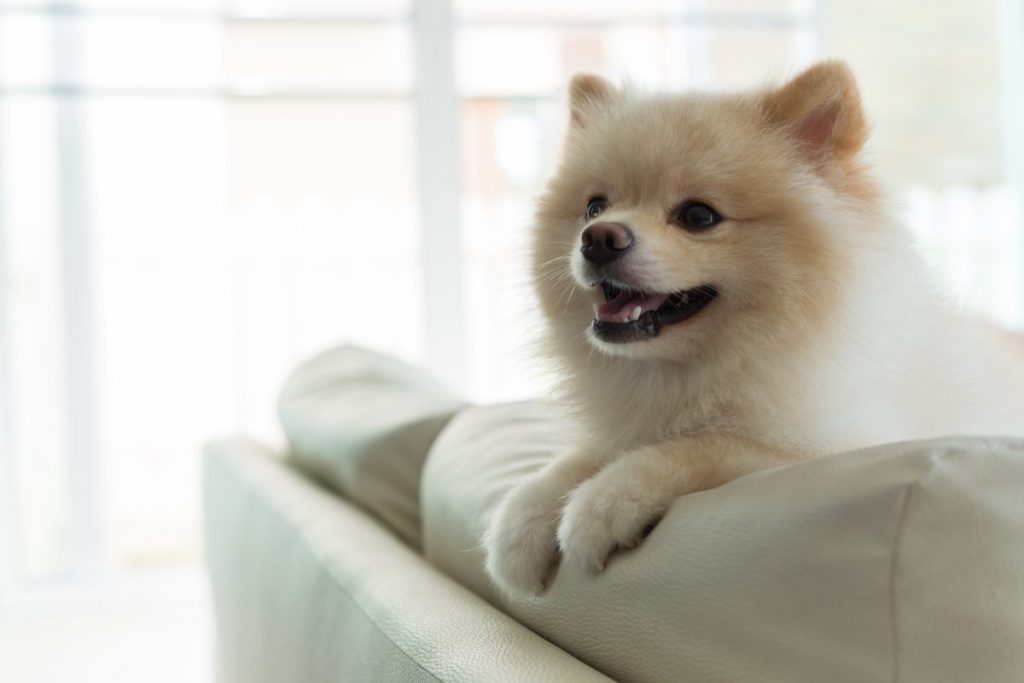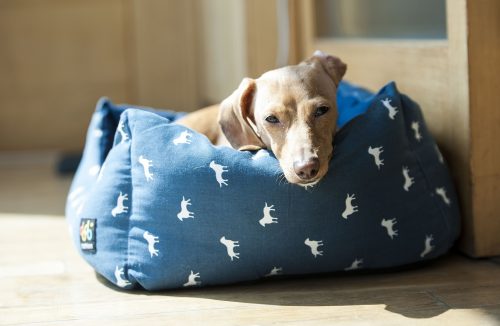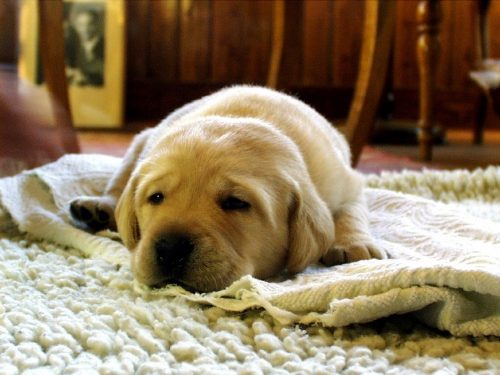House training your pup is top priority when bringing your new little family member home. It’s also one of the most prevalent reasons dogs find themselves homeless or living in an animal shelter.
Most people underestimate the work and the time required to house train a new dog. Potty training dogs isn’t always an easy feat and requires a significant amount of time and patience. They get frustrated over cleaning up constant messes and wind up getting rid of their new canine friend altogether. This is why it’s so important to think carefully before you bring a new pet home.
Keep in mind that every dog is unique, and some may catch on more quickly than others during the house training process. On average, it takes 4-6 months for a puppy to be potty trained. Factors like the size and age of your dog may impact how long it takes to potty train you puppy. Remember that consistency is key, and patience is necessary.
If you are not consistent with your actions when trying to teach your dog what they should and should not be doing, your dog will become confused and not understand what is expected of them. Achieving a good outcome depends entirely upon you.
The ideal age to begin house training a puppy is between 8 and 12 weeks old. This is not always feasible, especially if you choose to adopt an older dog. You don’t always know what you’re getting in those instances, and the dog may have never been house trained at all before.
Or the dog could have been an outside dog in his prior home, or perhaps he has anxiety or other physical or emotional issues that cause him to potty in the house. These factors can make house training difficult, to say the least.
But with consistency, most dogs still catch on relatively quickly. If your dog seems to be a little slow, just continue to be persistent and patient. He may need a little extra time and attention, but he will get there.
Some pups can take as long as a year to be fully housebroken, and every dog is unique. Of course, there are ways that you can help speed up the process, but it really depends on you, and how diligent you are in training.
It will also depend on your dog’s personality and quirks. Some dogs may have trouble picking things up, making the process take much longer than it might with another dog.
Tips to House Train Your Dog Faster
- The more involved you are, the shorter the amount of time it will take to house train your puppy. Your dog is like a child in many ways.
- If possible, try to take some time off so you can spend a significant amount of time focused solely on your new family member, and walk him through the house training process.
- If you absolutely cannot be there all the time, you may need to consider crate training, or confinement training to minimize mess when you are not home.
- Remember to reward your pup often to keep him motivated. Treats are excellent for this, as not all dogs will remain interested enough from praise alone. Be patient and reward him immediately when he succeeds.
- Set an alert on your phone and take your pup out every hour. Consistency and repetition is the name of the game. The more you take your pup out and he is rewarded for his success, the faster he will catch on to what you expect from him. Spreading out the timeframe in between bathroom breaks will only make the entire process take longer.
- Don’t punish your dog for having an accident. The only thing dogs learn by being punished for an accident is that he needs to fear you. Accidents happen, so just move on and up your game by taking him out more often.
Using Puppy Pads
Though puppy pads can be used to help train your pup faster, remember that you are teaching him a two-part process. Once you teach him to go on the pad, you can keep moving it closer to the door, until eventually you can begin to train him to go outside.
However, this can become confusing for your pooch, so it is usually easier to just teach him what you want him to do the first time around. Another thing to note is that though puppy pads can make the cleanup of messes easier, it can be more expensive. Pups love to shred things, including those lovely puppy pee pads you spend so much money on.
Confinement (Crate) Training
Of course, during house training, you will need a break or two. Your pup also needs plenty of rest. Crates are good because you can put your puppy in for a nap, and it will help to keep him confined and limit any accidents in your home. Crates are also good to keep your pup safe if he is a little explorer and likes to get into trouble, especially when you are unable to keep a close eye on him.
Keep in mind that you want the crate to be small enough for your dog to choose to resist the urge to soil in it. There should be just enough room to sit up, stand up, and move around, or turn around in a small circle. If you make it any bigger, he may soil his bed. Unfortunately, once that happens, he will then start to think that it’s okay to soil his bed, which is not the goal.
Your dog will then just make a place to sleep on the other side crate, away from his mess. Eventually you can increase the size of his crate as needed, but when you’re just getting started, it’s better to keep the space relatively small. Then as soon as you let your pup out of his crate, take him outside to where he is supposed to go, every single time.
Some Do’s and Don’ts of House Training Your Puppy
To make the housetraining process as quick as possible, your dog will require constant supervision. This is great if you stay at home or work from home, if you are retired, or if you can take some time off to stay home and spend it house training your pup. You’ll need to keep a close eye on your dog, so that you notice their potty cues such as sniffing and running in rapid little circles.
Unfortunately, even if you stay at home to do this, the method is not foolproof. It can be harder, because you must stay on top of your dog and be absolutely consistent. If you miss the signs and they have multiple accidents, you could be accidentally training them go potty in your house.
Another tip to keep in mind is every time you take your dog out, make sure your trip outside has a purpose. Don’t spend the time playing. Limit your trip outside to only going potty. This way, your dog will associate ‘going outside’ with ‘going potty’.
Verbal cues such as telling your dog to ‘go pee’ or ‘go potty’ can also be helpful in this regard. And while on the topic of verbal cues, it’s important to choose a word or phrase to instruct them to go potty that everyone in your family will use in the same way. If you all say it just a little bit differently, your dog will become confused and not understand what behavior is desired.
Some dogs may spontaneously go to the front door to let you know he wants to go out, but that’s not as common as one might think. It’s better to just use a cue like the word ‘outside’ to get him excited and headed for the door. As soon as your dog goes to the bathroom outside, praise him and then come right back in.
However, if you’re taking your pup outside to play (even if you know they will also end up going potty), do not use the word ‘outside’… choose another word such as ‘play’ or something else you can associate with going outside, like ‘walk’. You want him to learn to associate the word ‘outside’ only with going potty. Cues for dogs need to be clear and unambiguous for them to be learned properly and obeyed. Much like rules need to be clear-cut with humans!
Even after all your efforts at house training, if an accident occurs, remember not to punish your pup. Dogs aren’t hardwired the same as people, and their memories are foggier than humans. Your dog won’t understand why you’re punishing him or even make the connection between the accident and your current frustration or anger.
The only thing you will succeed in doing is making your dog scared of you and give him anxiety. Pups, much like toddlers, rarely think about what they did five minutes ago. They are just on to the next ‘fun thing’. Besides, if your dog is having accidents in the house, the reality is that it’s your fault. You aren’t watching closely enough and being consistent enough.
Owners that pay close attention to their puppy will notice a potty pattern right away, and can take him out and prevent most accidents. But when you’re not paying attention, you will miss the signs, and wind up with a mess to clean. Frustrating, yes, but it’s not your puppy’s fault you weren’t watching.
Another tip is to pay attention to the 15-minute rule. With the 15-minute rule, whenever your pup does something like drink or eat, play or wake from sleep, he needs to go outside sooner rather than later, ideally within 15 minutes of the activity to avoid an accident.
While pups can be trained to hold their bladders for extended periods of time, they aren’t very good at it at first. They tend to get better at it as they get older. The younger your dog is the more often you should take him out. A good benchmark is roughly every one to two hours. Especially if he’s just done something that falls under the 15-minute rule.
If you notice that your pup seems to have trouble holding his bladder no matter what you do or how consistent you are, you might have to see the vet. There could be an underlying medical cause you are unaware of.
Another tip is to gradually increase your pup’s confinement area. For instance, he might be allowed to hang out in the kitchen. Once he hangs out in the kitchen accident-free for a week, you can open another room in your house up, such as the living room.
Once he hangs out in the living room and the kitchen for a week with no accidents, then you can open a larger area of your home up, and so on. Eventually you will be able to allow him free reign in the entire house with no accidents, if you stay diligent.
Something that is also important is that you need to take your pup out during the night. This is especially true for very young dogs. If you don’t, and allow your dog to soil his bed, he will only become more and more comfy in a soiled environment. This makes it much harder to house train him and break poor habits.
Finally, it is extremely important to start house training your puppy exactly as you mean to go on. Yes, puppy pads and newspapers can be an acceptable way to help train a dog, and come in handy if you are away for long periods of time. Just be aware that it may get confusing for him as he gets older and you no longer want him to use those tools. It’s much better to train him right away to go outside, and avoid the confusion altogether.
At the end of the day, how fast or slowly your pup learns desired behaviors will depend entirely on you and how consistent you are in teaching him. Remember that dogs are like kids. Their training (or lack thereof) reflects you and the time you put into teaching them the behaviors you desire.
Sources:
- “House Training Your Puppy.” WebMD, Accessed 7 June 2017. www.pets.webmd.com/dogs/guide/house-training-your-puppy.
- “Toilet Training for Puppies: Basic Tips & Techniques.” The Kennel Club, Accessed 7 June 2017. www.thekennelclub.org.uk/getting-a-dog-or-puppy/general-advice-about-caring-for-your-new-puppy-or-dog/toilet-training-for-puppies/.
- “How Long Does It Take to Potty Train a Puppy?” Care.com, Accessed 7 June 2017. www.care.com/c/questions/8052/how-long-does-it-take-to-potty-train-a-puppy/.
- “Housebreaking Your Puppy: Do’s and Don’ts.” Cesar’s Way, 9 Nov. 2016, Accessed 7 June 2017. www.cesarsway.com/dog-training/housebreaking-issues/housebreaking.
- “How to Housetrain Your Dog or Puppy.” The Humane Society, Accessed 7 June 2017. www.humanesociety.org/resources/how-housetrain-your-dog-or-puppy.







